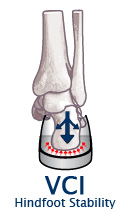Achilles Tendonitis
Print-Friendly VersionComplaints
- Pain and/or tenderness at insertion of tendon or along tendon
- Pain may increase with running, jumping and walking activities
- Swelling along the lower portion and insertion (at the heel) of the achilles tendon
Possible Causes
- Tight gastrocnemius (calf) / achilles tendon
- Excessive pronation
- Weak calf muscles
- Soft, unstable shoes
Shoe Profile
A shoe midsole with maximum torsional stability is necessary when the foot has excessive pronation. This reduces strain on the Achilles tendon and calf muscles, allowing them to function more efficiently. To lower the tractional (pulling) forces on the Achilles tendon, a shoe with a firm midsole under the heel and a high to medium heel-to-toe ratio is beneficial.
Orthotics
Neutral (mild pronators) – 3 mm heel lift with or without over-the-counter arch supports
Excessive pronators – Custom orthotics with 3 plus mm heel lifts
Shoe Recommendations
The following shoes meet these criteria. Please click on the appropriate link to see the shoes and their test data.
Recommended Accessories

SuperFeet arch supports
Provides a more balanced and biomechanically efficient foot that results in less stress to the achilles tendon.

Heel Lift
Reduces tension on the achilles tendon resulting in less pain. Should be worn on both feet.

The Stick
Effective way to massage the calf to reduce muscle tension and to improve flexibility. Increased flexibility results in less tension on the achilles tendon.

TheraBand Light Resistance Band Kit
Very handy for developing a strengthening program.

SKLZ Cold Roller Ball
Provides targeted massage with ice therapy to reduce inflammation and pain.
Exercises**
**Please consult your physican before engaging in an exercise program.**
With all strengthening exercises, start with 3 sets of 10. If you experience any sort of pain reduce your reps to 3 sets of 5 repetitions. For all stretches, repeat 3 times holding each stretch for 30 seconds to 1 minute. Using RICE (Rest, Ice, Compression, Elevation) can be beneficial in the treatment of injuries as well.
Gastrocnemius (calf) Standing Stretch |
Soleus Standing Stretch |
|
|
Heel Raises Exercise |
Foot Down Elastic Exercise |
|
|
Images reproduced courtesy of T.E.D.© (Therapeutic Exercise Database) V. 2.0






